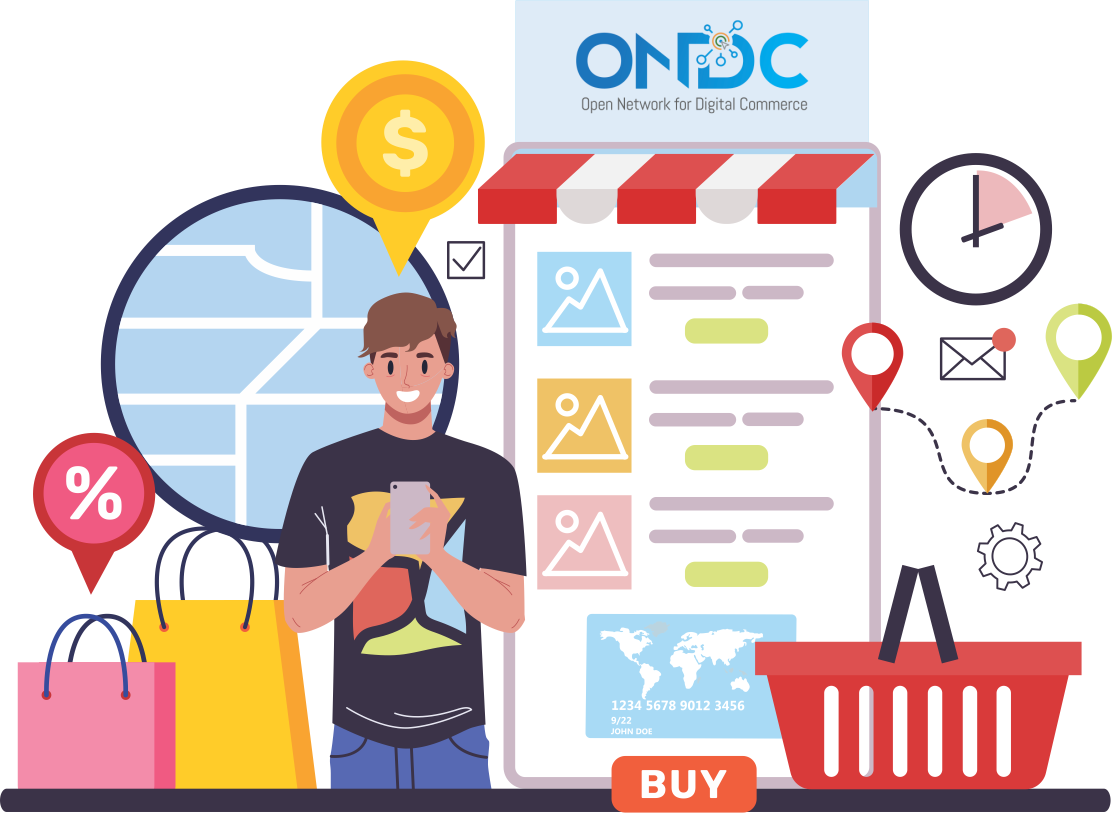Synopsis:
The Open Network for Digital Commerce (ONDC) aims to revolutionize India's e-commerce landscape. It fosters fair competition and innovation, democratizing digital commerce. ONDC API integration enables businesses to join either as Inventory Seller Nodes (ISN) or Marketplace Seller Nodes (MSN).
The platform shows promise, witnessing significant growth in categories like electronics and fashion. Leveraging ONDC eCommerce requires understanding its models and potentially partnering with a Technology Service Provider for integration and support.

In the dynamic world of e-commerce, the Open Network for Digital Commerce (ONDC) emerges as a significant platform poised to revolutionize the landscape for brands and businesses.
As an ambitious entrepreneur or an established brand seeking to expand your reach and tap into the vast potential of India's digital market, understanding the intricacies of ONDC and the steps to take your brand live on this platform becomes paramount.
In this comprehensive guide, we'll delve into the fundamental aspects of ONDC integration and ONDC API integration, explore its current traction and top-performing categories, discuss the process of going live, decipher the concepts of ISN and MSN, and shed light on the crucial role of a TSP (Technology Service Provider) in building ISN.
Understanding ONDC: A Brief Overview
The Open Network for Digital Commerce (ONDC) is an ambitious initiative by the Government of India aimed at creating a unified digital commerce ecosystem. Its primary objective is to democratize digital commerce, promote fair competition, and foster innovation in the e-commerce space.
ONDC API Integration envisions a level playing field where businesses of all sizes can thrive and consumers can benefit from a diverse range of products and services.
Estimates indicate that e-commerce in India has enormous potential. By 2030, the sector is expected to rise to a whopping $400 billion, with a Compound Annual Growth Rate (CAGR) of 19%.
Numerous variables, such as the growing middleclass population, increased digital literacy, and the expanding penetration of the internet, are responsible for this extraordinary development.
The Open Network for Digital Commerce (ONDC) is anticipated to be crucial in augmenting the industry's penetration in this revolutionary environment. With its forward-thinking strategy, ONDC hopes to level the playing field, encourage healthy competition among e-commerce companies, and support the growth of small enterprises.
The ONDC eCommerce aims to expand the reach of e-commerce, especially in rural and underserved regions, by using technology and promoting interoperability. This would help to ensure that the digital economy in India grows inclusively.
The ONDC programme promises to democratise e-commerce and drive its exponential growth as the country moves closer to a digital future.
Current Traction and Top-Performing Categories on ONDC
As ONDC eCommerce gains momentum, various categories are witnessing substantial traction. Essential categories such as electronics, fashion apparel, home essentials, and consumer goods are performing exceptionally well.
ONDC has also witnessed remarkable growth and success. In the past year, the number of merchants has experienced an extraordinary increase, reflecting the widespread adoption of ONDC API integration by businesses across India.
Moreover, the daily order volume for retail orders has reached a run rate of 70,000 as on December 2023, reflecting a 1500x jump over the same time a year ago, illustrating the increasing popularity and effectiveness of the ONDC eCommerce platform.
Within the retail category, food and beverages accounted for 32.5% of the orders, followed by fashion (29.6%), with the remaining transactions spread across categories such as home and kitchen (12.6%), grocery (10.1%), beauty and personal care (8.5%), and electronics (5.7%).
ONDC eCommerce is facilitating a shift in market share, with smaller sellers in key categories like fashion apparel (contributing 48.5% of current GMV) gaining traction alongside established players, potentially leading to a more diverse and competitive e-commerce landscape.
Looking ahead, the future impact of ONDC eCommerce on the Indian digital commerce ecosystem is promising. The initiative will fuel innovation and encourage the development of new business models tailored to hyper- local needs. This, in turn, will create employment opportunities and boost entrepreneurship at the grassroots level.
How to Go Live on ONDC: MSN and ISN
If you're considering joining ONDC eCommerce, you'll need to choose between becoming an Inventory Seller Node (ISN) or joining as a Marketplace Seller Node (MSN), or you can opt to become a seller on an existing MSN like MyStore or eSamudaay
Ways to join ONDC:
1. Becoming an Inventory Seller Node (ISN)
2. Becoming a Marketplace Seller Node (MSN)
3. Joining an existing MSN
The decision depends on factors such as your budget, marketing goals, inventory size, and your business model. The following section provides a comparison of the three models available on ONDC to help businesses choose the most suitable option for their use case.
1. Becoming an Inventory Seller Node (ISN)
A brand can opt to become an Inventory Seller Node (ISN) on the ONDC Network. As an ISN, the brand acts as the "seller on record" for their goods and services on the network. Once integrated to the network, the brand’s catalogue is visible across all buyer apps.
Being an ISN-NP (an Inventory Seller Node-Network Participant) means the brand operates independently on ONDC without association with other sellers, distributors, or retailers. The brand has complete control over payments and delivery. This setup is advantageous for brands and large D2C players. Below are some of the benefits of this model –
- 1. Payments are received directly into the nodal account and not routed through a 3rd party, leading to faster settlements.
- 2. Allows brands to keep more of their profits.
- 3. Brands have complete control over delivery which allows them to manage the post order experience vs. relying on a 3rd party.
- 4. Solution can be integrated with the brand’s back-end systems such as website or order management system.
2. Becoming a Marketplace Seller Node (MSN)
As an MSN, the brand acts as the marketplace, facilitating the sale of goods and services offered by third-party merchants or service providers to buyers accessing the network. The brand, in this role, does not act as the "seller on record," but rather the third-party merchants or sellers fulfil that role.
Being an MSN allows the brand to control its sellers, provide a common storefront, manage inventory, and handle payments and deliveries. This approach is suitable for large consumer goods companies who have a distribution network. It will also work for brands with FDI who cannot be ‘sellers on record’ on the network. Below are some of the benefits of this model –
- 1. Enables brands to standardise the catalogue and pricing. Consumers get to see the same catalogue irrespective of the seller.
- 2. Brands can leverage their existing distribution network to service consumers.
- 3. Brands have data ownership over sales from the network.
3. Joining an existing MSN
MSNs, such as MyStore or eSamudaay, act as aggregators on the ONDC eCommerce platform, allowing market sellers (who are not network participants themselves) to conduct transactions.
By joining as a seller through an established MSN, you can sell your products through an existing e-commerce marketplace within the ONDC network. This model offers the advantage of quick onboarding without the need of expensive integrations and compliance procedures.
It enables brands to rapidly reach a larger audience and leverage established marketing and advertising channels. Moreover, MSNs handle storefront setup, inventory management, payment processing, and deliveries, allowing brands to focus on product quality and service excellence.
However, there are some drawbacks to joining as a seller on an MSN. These include higher commission fees and limited control over branding and customization compared to ISNs. Additionally, existing Sellers on MSNs have significant competition from other sellers on the same platform, which can make it challenging to stand out from the crowd.
onIt is important to note that as a seller on an MSN, you will not be a registered entity on the ONDC Network, as the MSN itself is the registered entity. Below are some of the benefits of joining an existing MSN –
- 1. Quick onboarding as existing MSNs have seller panels to enable cataloguing and order management.
- 2. Low cost of onboarding as no direct integration is required with ONDC network.
Pros and cons of the 3 models
The below table summarises the Pros and Cons of each of the above models.
| Model |
Pros |
Cons |
| Becoming an ISN |
1. Complete control over inventory, operations, and delivery
2. Faster payment settlement
3. Higher profitability due to low/no commissions compared to joining an MSN.
4. Solutions can be fully customized and integrated with existing systems.
|
1. May be time consuming.
2. May required some technical capabilities to develop and integrate.
|
| Becoming an MSN |
1. Ability to utilize existing distribution channel to sell to consumers online.
2. No need to dedicate inventory for ONDC eCommerce.
3. Brands can standardise the catalogue for uniform experience.
4. Orders are delivered from nearest seller thereby reducing delivery TAT.
|
1. Creating and managing a marketplace requires time and resources to onboard and manage sellers.
2. Required deep technical capabilities. Alternatively, services of a technology service provider will be required.
|
| Joining an existing MSN |
1. Low investment and quick go live. |
2. Solution is not customized or integrated with existing systems of the brand.
3. Requires separate cataloguing and order management.
4. MSN may charge up to 3% commissions on sales and hence may impact profitability as the business grows.
|
Evaluating the above factors can help you to zero down on the right model to use to go live on the ONDC API integration network. If your decision is to become as ISN or MSN on the network, you will need to consider the investment in developing and integrating the platform. This can be time consuming and technologically complex. Partnering with a technology service provider (TSP) can mitigate these challenges and reduce costs.
The Role of a TSP in Building ISN
A Technology Service Provider (TSP) plays a crucial role in helping brands in building and maintaining ISN or MSN infrastructure. Here's how a TSP can contribute to your ISN or MSN:
1. Technical Expertise
TSPs possess the technical expertise and experience required to design, develop, and deploy robust ISN and MSN solutions tailored to your specific requirements.
2. Integration and Customization
TSPs work closely with brands to integrate their existing back-end systems with the ONDC eCommerce platform, ensuring seamless data exchange and interoperability.
3. Compliance and Security
TSPs help ensure compliance with ONDC API integration guidelines and industry standards while implementing robust security measures to safeguard sensitive data and transactions.
4. Ongoing Support and Maintenance
TSPs provide ongoing support and maintenance services to ensure the smooth operation of your ISN, address any issues promptly, and keep pace with evolving requirements.
In conclusion, embracing ONDC eCommerce presents a tremendous opportunity for brands and businesses to tap into India's burgeoning digital commerce market. By understanding the core concepts, navigating the registration process, and leveraging the expertise of technology partners, you can take your brand live on ONDC eCommerce and unlock new avenues for growth and expansion in the digital era.





